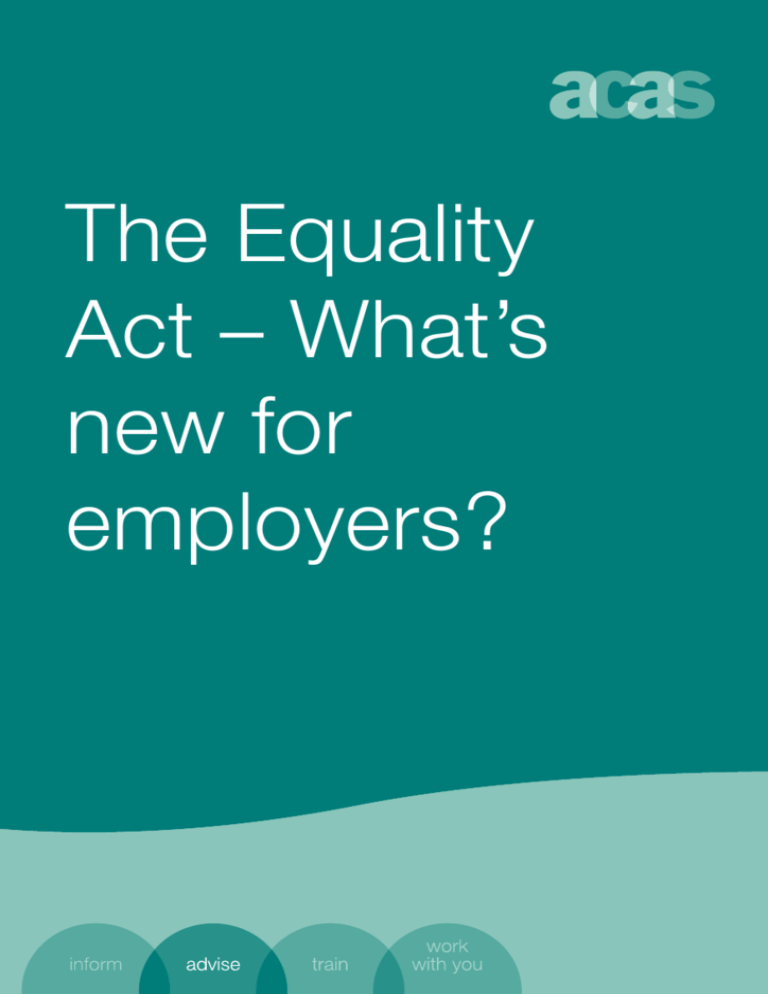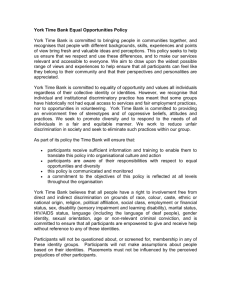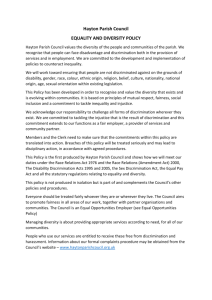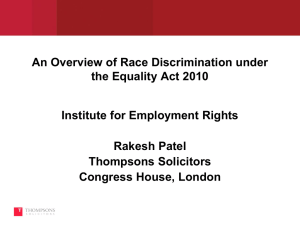The Equality Act – What's new for employers?
advertisement

The Equality Act – What’s new for employers? Acascanhelpwithyour employmentrelations Every year Acas helps employers and employees from thousands of workplaces. That means we keep right up to date with today’s employment relations issues – such as discipline and grievance handling, preventing discrimination and communicating effectively in workplaces. Make the most of our practical experience for your organisation – find out what we can do for you. Weinform We answer your questions, give you the facts you need and talk through your options. You can then make informed decisions. Contact us to keep on top of what employment rights legislation means in practice – before it gets on top of you. Call our helpline 08457474747or visit our website www.acas.org.uk. Weadviseandguide We give you practical know-how on setting up and keeping good relations in your organisation. Look at our publications on the website or ask our helpline to put you in touch with your local Acas adviser. Our Equality Direct helpline 08456003444advises on equality issues, such as discrimination. Wetrain From a two-hour session on the key points of new legislation or employing people to courses specially designed for people in your organisation, we offer training to suit you. Look on the website for what is coming up in your area and to book a place or talk to your local Acas office about our tailored services. Weworkwithyou We offer hands-on practical help and support to tackle issues in your business with you. This might be through one of our well-known problem-solving services. Or a programme we have worked out together to put your business firmly on track for effective employment relations. You will meet your Acas adviser and discuss exactly what is needed before giving any go-ahead. Introduction– what’snew intheEqualityAct2010? This guide covers the provisions of the Equality Act which will become law in October 2010. As an employer, your obligations remain largely the same. The Act harmonises and replaces previous legislation (such as the Race Relations Act 1976 and the Disability Discrimination Act 1995) and ensures consistency in what you need to do to make your workplace a fair environment and to comply with the law. The Equality Act covers the same groups that were protected by existing equality legislation – age, disability, gender reassignment, race, religion or belief, sex, sexual orientation, marriage and civil partnership and pregnancy and maternity. These are now called ‘protected characteristics’ and are described on pages 5-7 of this guide. The Act extends some protections to characteristics that were not previously covered, and also strengthens particular aspects of equality law. As a result, you may need to review and change some of your policies and practices. This guide will help you to identify where you need to take action. INTRODUCTION– WHAT’S NEW IN THE EQUALITY ACT 2010? 1 2 What’s new & what’s changed: at a glance [ New New New New New New Pregnancy & Maternity New Types of discrimination – see page 3 Marriage & Civil Partnership New Sexual Orientation New Characteristic not covered in existing legislation – still not covered Sex New Religion or Belief Characteristic not covered in existing legislation – now covered Race Changes Gender Reassignment Characteristic covered in existing legislation – but some changes Disability Characteristic covered in existing legislation – no changes Age THE EQUALITY ACT– WHAT’S NEW FOR EMPLOYERS? Protected characteristics (PC) – see page 5 Key DIRECT DISCRIMINATION Someone is treated less favourably than another person because of a protected characteristic (PC) DISCRIMINATION BY ASSOCIATION Direct discrimination against someone because they associate with another person who possesses a PC DISCRIMINATION BY PERCEPTION Direct discrimination against someone because the others think they possess a particular PC INDIRECT DISCRIMINATION Can occur when you have a rule or policy that applies to everyone but disadvantages a particular PC HARASSMENT Employees can now complain of behaviour they find offensive even if it is not directed at them HARASSMENT BY A THIRD PARTY Employers are potentially liable for harassment of their staff by people they don’t employ VICTIMISATION Someone is treated badly because they have made/ supported a complaint or grievance under the Act Changes Changes Changes Changes Changes New New New New New Changes New Changes Changes Changes Changes Changes Changes Changes Changes Changes Typesofdiscrimination: definitions Directdiscrimination Direct discrimination occurs when someone is treated less favourably than another person because of a protected characteristic they have or are thought to have (see perception discrimination below), or because they associate with someone who has a protected characteristic (see discrimination by association below). Annex 1 contains an example of direct discrimination. Discriminationbyassociation Already applies to race, religion or belief and sexual orientation. Now extended to cover age, disability, gender reassignment and sex. This is direct discrimination against someone because they associate with another person who possesses a protected characteristic. See Annex 1 for an example of discrimination by association. Perceptiondiscrimination Already applies to age, race, religion or belief and sexual orientation. Now extended to cover disability, gender reassignment and sex. This is direct discrimination against an individual because others think they possess a particular protected characteristic. It applies even if the person does not actually possess that characteristic. See Annex 1 for an example of perception discrimination. Indirectdiscrimination Already applies to age, race, religion or belief, sex, sexual orientation and marriage and civil partnership. Now extended to cover disability and gender reassignment. Indirect discrimination can occur when you have a condition, rule, policy or even a practice in your company that applies to everyone but particularly disadvantages people who share a protected characteristic. Indirect discrimination can be justified if you can show that you acted reasonably in managing your business, ie that it is ‘a proportionate means of achieving TYPES OF DISCRIMINATION: DEFINITIONS 3 a legitimate aim’. A legitimate aim might be any lawful decision you make in running your business or organisation, but if there is a discriminatory effect, the sole aim of reducing costs is likely to be unlawful. Being proportionate really means being fair and reasonable, including showing that you’ve looked at ‘less discriminatory’ alternatives to any decision you make. Annex 1 contains an example of indirect discrimination. Harassment Harassment is “unwantedconductrelatedtoarelevantprotected characteristic,whichhasthepurposeoreffectofviolatinganindividual’s dignityorcreatinganintimidating,hostile,degrading,humiliatingor offensiveenvironmentforthatindividual”. Harassment applies to all protected characteristics except for pregnancy and maternity and marriage and civil partnership. Employees will now be able to complain of behaviour that they find offensive even if it is not directed at them, and the complainant need not possess the relevant characteristic themselves. Employees are also protected from harassment because of perception and association (see page 3). See Annex 1 for some examples of harassment. Thirdpartyharassment Already applies to sex. Now extended to cover age, disability, gender reassignment, race, religion or belief and sexual orientation. The Equality Act makes you potentially liable for harassment of your employees by people (third parties) who are not employees of your company, such as customers or clients. You will only be liable when harassment has occurred on at least two previous occasions, you are aware that it has taken place, and have not taken reasonable steps to prevent it from happening again. See Annex 1 for an example of third party harassment. Victimisation Victimisation occurs when an employee is treated badly because they have made or supported a complaint or raised a grievance under the Equality Act; or because they are suspected of doing so. An employee is not protected from victimisation if they have maliciously made or supported an untrue complaint. There is no longer a need to compare treatment of a complainant with that of a person who has not made or supported a complaint under the Act. See Annex 1 for an example of victimisation. 4 THE EQUALITY ACT– WHAT’S NEW FOR EMPLOYERS? TheProtected Characteristics:keypoints •Age •Disability •GenderReassignment •MarriageandCivilPartnership •PregnancyandMaternity •Race •ReligionorBelief •Sex •SexualOrientation The table on page 2 of this guide shows the forms of discrimination which apply to each protected characteristic. Age(nochange) The Act protects people of all ages. However, different treatment because of age is not unlawful direct or indirect discrimination if you can justify it, ie if you can demonstrate that it is a proportionate means of meeting a legitimate aim. Age is the only protected characteristic that allows employers to justify direct discrimination. The Act continues to allow employers to have a default retirement age of 65 until April 2011. Disability(newdefinitionandchanges) The Act has made it easier for a person to show that they are disabled and protected from disability discrimination. Under the Act, a person is disabled if they have a physical or mental impairment which has a substantial and longterm adverse effect on their ability to carry out normal day-to-day activities, which would include things like using a telephone, reading a book or using public transport. THE PROTECTED CHARACTERISTICS: KEY POINTS 5 As before, the Act puts a duty on you as an employer to make reasonable adjustments for your staff to help them overcome disadvantage resulting from an impairment (eg by providing assistive technologies to help visually impaired staff use computers effectively). The Act includes a new protection from discrimination arising from disability. This states that it is discrimination to treat a disabled person unfavourably because of something connected with their disability (eg a tendency to make spelling mistakes arising from dyslexia). This type of discrimination is unlawful where the employer or other person acting for the employer knows, or could reasonably be expected to know, that the person has a disability. This type of discrimination is only justifiable if an employer can show that it is a proportionate means of achieving a legitimate aim. Additionally, indirect discrimination now covers disabled people. This means that a job applicant or employee could claim that a particular rule or requirement you have in place disadvantages people with the same disability. Unless you could justify this, it would be unlawful. The Act also includes a new provision which makes it unlawful, except in certain circumstances, for employers to ask about a candidate’s health before offering them work. See page 8. Genderreassignment(newdefinition) The Act provides protection for transsexual people. A transsexual person is someone who proposes to, starts or has completed a process to change his or her gender. The Act no longer requires a person to be under medical supervision to be protected – so a woman who decides to live as a man but does not undergo any medical procedures would be covered. It is discrimination to treat transsexual people less favourably for being absent from work because they propose to undergo, are undergoing or have undergone gender reassignment than they would be treated if they were absent because they were ill or injured. Marriageandcivilpartnership(nochange) The Act protects employees who are married or in a civil partnership against discrimination. Single people are not protected. 6 THE EQUALITY ACT– WHAT’S NEW FOR EMPLOYERS? Pregnancyandmaternity(nochange) A woman is protected against discrimination on the grounds of pregnancy and maternity during the period of her pregnancy and any statutory maternity leave to which she is entitled. During this period, pregnancy and maternity discrimination cannot be treated as sex discrimination. See Annex 1 for an example. You must not take into account an employee’s period of absence due to pregnancy-related illness when making a decision about her employment. Race(nochange) For the purposes of the Act ‘race’ includes colour, nationality and ethnic or national origins. Religionorbelief(nochange) In the Equality Act, religion includes any religion. It also includes a lack of religion, in other words employees or jobseekers are protected if they do not follow a certain religion or have no religion at all. Additionally, a religion must have a clear structure and belief system. Belief means any religious or philosophical belief or a lack of such belief. To be protected, a belief must satisfy various criteria, including that it is a weighty and substantial aspect of human life and behaviour. Denominations or sects within a religion can be considered a protected religion or religious belief. Discrimination because of religion or belief can occur even where both the discriminator and recipient are of the same religion or belief. Sex(nochange) Both men and women are protected under the Act. Sexualorientation(nochange) The Act protects bisexual, gay, heterosexual and lesbian people. THE PROTECTED CHARACTERISTICS: KEY POINTS 7 EqualityAct- Somekeychangesyouneedtoknow about Positiveaction As with previous equality legislation, the Equality Act allows you to take positive action if you think that employees or job applicants who share a particular protected characteristic suffer a disadvantage connected to that characteristic, or if their participation in an activity is disproportionately low. Annex 2 gives an example of positive action. The Equality Act 2010 from April 2011 allows you, if you want to, to take a protected characteristic into consideration when deciding who to recruit or promote. However, you can only do this when you have candidates who are “as qualified as” each other for a particular vacancy. This does not mean they have to have exactly the same qualifications as each other, it means that your selection assessment on a range of criteria rates them as equally capable of doing the job. You would also need some evidence to show that people with that characteristic face particular difficulties in the workplace or are disproportionately under-represented in your workforce or in the particular job for which there is a vacancy. In these circumstances, you can choose to use the fact that a candidate has a protected characteristic as a ‘tie-breaker’ when determining which one to appoint. You must not have a policy of automatically treating job applicants who share a protected characteristic more favourably in recruitment and promotion. This means you must always consider the abilities, merits, and qualifications of all of the candidates in each recruitment or promotion exercise. Otherwise, your actions would be unlawful and discriminatory – an example is given in Annex 2. 8 THE EQUALITY ACT– WHAT’S NEW FOR EMPLOYERS? Pre-employmenthealth-relatedchecks The Equality Act limits the circumstances when you can ask health-related questions before you have offered the individual a job. Up to this point, you can only ask health-related questions to help you to: • decide whether you need to make any reasonable adjustments for the person to the selection process The Holmwood Gazette is recruiting for a receptionist. The newspaper’s application form asks health questions. These are removed to prevent them being considered at this stage. The newspaper still asks applicants if they require any reasonable adjustments to the interview process to ensure everyone can give of their best during the meeting. However they do not take this information into account when deciding who to employ. • decide whether an applicant can carry out a function that is essential (‘intrinsic’) to the job If the newspaper has a job that requires a lot of heavy manual handling, they could ask a candidate with a mobility impairment whether they could manage handling heavy goods. However, the newspaper would not be able to ask the person how their impairment would affect them in getting to the workplace, because this is not something that is intrinsic to the job itself. • monitor diversity among people making applications for jobs The Gazette, which has a small proportion of disabled people working for it, may decide to ask applicants to state whether they have a disability, so that it can see whether its advertisements are reaching disabled people. • take positive action to assist disabled people The Gazette wishes to improve disabled people’s chances of being selected for its vacancies. Therefore it offers guaranteed interviews to disabled people. In order to identify disabled people, it asks on the application form whether the candidate has a disability, and makes clear why the question is being asked. EQUALITY ACT– SOME KEY CHANGES YOU NEED TO KNOW ABOUT 9 • assure yourself that a candidate has the disability where the job genuinely requires the jobholder to have a disability A counselling service for people with mental health conditions requires a counsellor who has personal experience of mental health conditions. The Service advertises for candidates who have such a condition, it is allowed to ask at interview for the person to confirm that they have the condition. A jobseeker cannot take you to an Employment Tribunal if they think you are acting unlawfully by asking questions that are prohibited, though they can complain to the Equality and Human Rights Commission. However, if you do ask these prohibited questions, and not employ the applicant, they may bring a claim of discrimination against you and the burden of proof would be on you to demonstrate that you had not discriminated. Once a person has passed the interview and you have offered them a job (whether this is an unconditional or conditional job offer) you are permitted to ask appropriate health-related questions. Extensionofemploymenttribunalpowers Under previous legislation, an employment tribunal could make a recommendation that an employer must eliminate or reduce the effect on the claimant of any discrimination. The Act extends this power so that it will now be possible for a tribunal to make recommendations that an organisation takes steps to eliminate or reduce the effect of discrimination on other employees, not only on the claimant. For example, the tribunal might specify that an employer needs to train all staff about the organisation’s bullying and harassment policy. This power does not apply to equal pay cases. See Annex 2 for an example of how Tribunal recommendations may affect you. Equalpay–directdiscrimination The Equality Act retains the framework that was previously in place. This means that in most circumstances a challenge to pay inequality and other contractual terms and conditions still has to be made by comparison with a real person of the opposite sex in the same employment. However, a change in the Equality Act allows a claim of direct pay discrimination to be made, even if no real person comparator can be found. This means that a claimant who can show evidence that they would have received better remuneration from their employer if they were of a different 10 THE EQUALITY ACT– WHAT’S NEW FOR EMPLOYERS? sex may have a claim, even if there is no-one of the opposite sex doing equal work in the organisation. This would be a claim under sex discrimination. Paysecrecy The Act makes it unlawful for you to prevent or restrict your employees from having a discussion to establish if differences in pay exist that are related to protected characteristics.It also makes terms of the contract of employment that require pay secrecy unenforceable because of these discussions. See Annex 2 for an example. An employer can require their employees to keep pay rates confidential from some people outside the workplace, for example a competitor organisation. ANNEX 1– EXAMPLES OF TYPES OF DISCRIMINATION 11 Annex1– Examplesoftypesofdiscrimination Directdiscrimination Paul, a senior manager, turns down Angela’s application for promotion to a supervisor position. Angela, who is a lesbian, learns that Paul did this because he believes the team that she applied to manage are homophobic. Paul thought that Angela’s sexual orientation would prevent her from gaining the team’s respect and managing them effectively. This is direct sexual orientation discrimination against Angela. Discriminationbyassociation June works as a project manager and is looking forward to a promised promotion. However, after she tells her boss that her mother, who lives at home, has had a stroke, the promotion is withdrawn. This may be discrimination against June because of her associationwith a disabled person. Perceptiondiscrimination Jim is 45 but looks much younger. Many people assume that he is in his mid 20s. He is not allowed to represent his company at an international meeting because the Managing Director thinks that he is too young. Jim has been discriminated against on the perception of a protected characteristic. 12 THE EQUALITY ACT– WHAT’S NEW FOR EMPLOYERS? Indirectdiscrimination A small finance company needs its staff to work late on a Friday afternoon to analyse stock prices in the American finance market. The figures arrive late on Friday because of the global time differences. During the winter some staff would like to be released early on Friday aftenoon in order to be home before sunset – a requirement of their religion. They propose to make the time up later during the remainder of the week. The company is not able to agree to this request because the American figures are necessary to the business, they need to be worked on immediately and the company is too small to have anyone else able to do the work. The requirement to work on Friday afternoon is not unlawful indirect discrimination as it meets a legitimate business aim and there is no alternative means to available. Harassment Paul is disabled and is claiming harassment against his line manager after she frequently teased and humiliated him about his disability. Richard shares an office with Paul and he too is claiming harassment, even though he is not disabled, as the manager’s behaviour has also created an offensive environment for him. Steve is continually being called gay and other related names by a group of employees at his work. Homophobic comments have been posted on the staff noticeboard about him by people from this group. Steve was recently physically pushed to the floor by one member of the group but is too scared to take action. Steve is not gay but heterosexual; furthermore the group know he isn’t gay. This is harassment because of sexual orientation. ANNEX 1– EXAMPLES OF TYPES OF DISCRIMINATION 13 Thirdpartyharassment Chris manages a Council Benefits Office. One of his staff, Frank, is gay. Frank mentions to Chris that he is feeling unhappy after a claimant made homophobic remarks in his hearing. Chris is concerned and monitors the situation. Within a few days the claimant makes further offensive remarks. Chris reacts by having a word with the claimant, pointing out that this behaviour is unacceptable. He considers following it up with a letter to him pointing out that he will ban him if this happens again. Chris keeps Frank in the picture with the actions he is taking and believes he is taking reasonable steps to protect Frank from third party harassment. Victimisation Anne makes a formal complaint against her manager because she feels that she has been discriminated against because of marriage. Although the complaint is resolved through the organisation’s grievance procedures, Anne is subsequently ostracised by her colleagues, including her manager. She could claim victimisation. Pregnancyandmaternity Lydia is pregnant and works at a call centre. The manager knows Lydia is pregnant but still disciplines her for taking too many toilet breaks as the manager would for any other member of staff. This is discrimination because of pregnancy and maternity as this characteristic doesn’t require the normal comparison of treatment with other employees. 14 THE EQUALITY ACT– WHAT’S NEW FOR EMPLOYERS? Annex2– Examplesofsomechangesinthe EqualityAct Positiveaction Marina and Co are manufacturers of bathroom taps and showers. They notice that they have no female sales representatives compared to men and find out that female employees are put off because of the apparent ‘all male environment’ in the sales team, many of whom are former plumbers. Marina reckons from its market research that the sales team will be more profitable with female representatives because the purchasers of taps and showers are often women who would appreciate a more representative sales team. The company sets up a programme of training and development for female employees where they can develop their skills and knowledge to become proficient in this area. At the subsequent recruitment of sales representatives, nearly half of new recruits were female and early sales returns for the last quarter are up. Positiveactioninrecruitmentandselection Loughton on Sea, a London commuter town and seaside resort has a population of some 75,000 of which around 15% at the last Census were from minority ethnic groups. The local High School has 1500 pupils that reflect the Census demographics and 80 teachers. The school has clear equality policies in place and has trained staff in these issues including the Equality Act 2010. Furthermore it has robust anti bullying policies for all staff to identify and tackle inappropriate harassing behaviour. The school is recruiting for a new Head of Department. None of the existing 10 departmental heads are from minority communities. The school runs an interview selection process where all candidates are scored against a range of job based questions. The selection panel also objectively assess the experience and qualifications of each candidate. ANNEX 2– EXAMPLES OF SOME CHANGES IN THE EQUALITY ACT 15 LoughtonSchoolexamplecontinued At the end of the selection process, two candidates have equal scores. Both are women. One of the women is black. The head thinks it important that the School’s senior leadership reflects the population of Loughton and the school, and so decides to use this provision in the Equality Act to appoint the black candidate. The Head gives feedback to the unsuccessful candidate and explains the position the School has taken and why. EmploymentTribunalrecommendations Simon is being harassed at work because he is undergoing gender reassignment. Simon complains and uses the company grievance procedures but nothing happens. Simon makes a claim to an Employment Tribunal who find in his favour. The Tribunal also make recommendations that the employer publishes an anti-harassment policy and trains all staff to understand it. Before the case came to Tribunal Simon leaves the company. Under the old legislation, the Tribunal could not make recommendations as Simon had left the employer. Now, even though Simon no longer works there, the Tribunal can make recommendations and the employer is still required to act on them for the benefit of other employees in the organisation. Paysecrecyintheworkplace Rashid works in a small fabrication company assembling motorcycle seats. The owner of the company decides on pay for each employee and Rashid, who is disabled, reckons he is being paid less than George because of this. Rashid asks George how much he earns. The owner learns of this discussion and disciplines Rashid; this is unlawful and Rashid may have a claim for victimisation. 16 THE EQUALITY ACT– WHAT’S NEW FOR EMPLOYERS? Furtherinformation Acas website www.acas.org.uk The Equalities and Human Rights Commission www.equalityhumanrights.com The Government Equalities Office www.equalities.gov.uk Business Link www.businesslink.gov.uk Direct.Gov www.direct.gov.uk Information in this booklet has been revised up to the date of the last reprint – see date below. For more up-to-date information, please check the Acas website at www.acas.org.uk. Legal information is provided for guidance only and should not be regarded as an authoritative statement of the law, which can only be made by reference to the particular circumstances which apply. It may, therefore, be wise to seek legal advice. � Acas aims to improve organisations and working life through better employment relations. We provide up-to-date information, independent advice, high quality training and we work with employers and employees to solve problems and improve performance. � We are an independent, publicly-funded organisation and many of our services are free. � January 2011 � Acas’ main offices: • National London • SouthEast Paddock Wood, Kent • EastMidlands Nottingham • SouthEast Fleet, Hampshire • EastofEngland Bury St Edmunds, Suffolk • SouthWest Bristol • London • WestMidlands Birmingham • NorthEast Newcastle upon Tyne • NorthWest Manchester • NorthWest Liverpool • YorkshireandHumber Leeds • Scotland Glasgow • Wales Cardiff Helpline 08457 47 47 47 � To view a full list of Acas publications go to www.acas.org.uk/publications 08457 38 37 36 Acas Customer Services Team who can provide details of services and training in your area or visit www.acas.org.uk/training www.acas.org.uk 01/11 AL13 08456 00 34 44 for questions on managing equality in the workplace







